One of the fundamentals of weight training is load progression [1]. Many fitness programs incorporate load progression by requiring the addition of incremental weights from one workout to the next. For instance, with High Intensity Training ( HIT), one may add anywhere from 0.5 lb up to 1 lb or more to the bar each workout session [2].
With Hypertrophy-Specific TrainingTM (HST), one typically adds 5% of one's 5 rep-max (RM) weight to the bar during each workout session [3-5]. Many other lifting programs also call for the use of similar load progression schemes.
One problem, however, is that weight plates are 2.5 lbs or 2.0 kg at their smallest. This limits the lifter to 5-lb or 4-kg increments, which may be too much in some instances. There's no question that smaller, micro-weights have their rightful place among our training equipment. The question is, however, what should we use for our micro-weights?
One solution is to purchase fabricated micro-weights from a vendor, such as Piedmont Design Associates [6]. Piedmont Design Associates makes fractional plates ranging from as small as 1 ounce to as large as 1.75 lbs. Fractional plates can be conveniently placed on barbells and dumbbells in the same manner as your larger weight plates. But it could be very expensive to purchase a whole set of fractional plates.
Another solution is to purchase a set of magnets, each of which having a known weight. Magnets can be attached to your weight plates, or even to your barbells and dumbbells to add incremental weight to your lifts. Although prices may vary, it's likely that purchasing a whole set of magnets having enough weight will be far more expensive than making your own micro-weights. An easy to make and convenient to use ½-lb micro-weight can be formed out of chain, as shown in Figure 1.
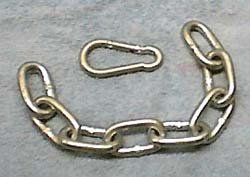
Figure 1: One ½-lb micro-weight
The ½-lb micro-weight shown in Figure 1 is comprised of 8 links of ¼-inch welded chain and one 5/16-inch stainless steel snap hook. The micro-weight is formed by simply attaching the snap hook onto one end of the chain, as shown in Figure 2.
The snap hook makes it easy to form the chain into a loop suitable for placing onto barbells and dumbbells, as well as attaching the chain to other chains or even to your dipping belt! The looped chain shown in Figure 2 has an inside diameter of about 2.5 inches-more than enough to fit onto both Standard and Olympic barbells.
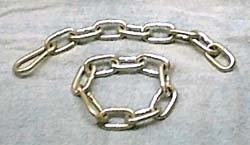
Figure 2: Chain micro-weight formed into a loop
Using chain micro-weights is straightforward and easy. You simply add chains to add more weight, just like with normal weight plates. For example, placing 1 chain on each end of a barbell provides a micro-weight of 1 lb. Placing 4 chains on each end of the barbell provides a weight of 4 lbs. Figure 3 shows a total weight of 26 lbs being placed on one end of a Standard barbell.
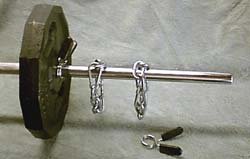
Figure 3: 26 lbs on one end of a barbell
Notice that a first ring clip is used to secure the 25-lb plate before the chains are placed on the barbell. A second ring clip is then used to hold the chains in place, as shown in Figure 4.
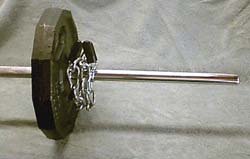
Figure 4: 26 lbs secured to the barbell
As you can see, the second ring clip is placed backwards on the barbell. The chains are held securely between the ring clips while also keeping the 25-lb plate secured to the barbell. This configuration prevents the weight plate and the chains from moving around on the barbell during your lifts! It's also worth mentioning that the configuration shown in Figure 4 can be used with your dumbbells, too.
So how many chain micro-weights will you need? Considering that you may want to increment your dumbbell weights anywhere from ½ lb up to 4 lbs, you'll need at least 16 chains. That gives you enough chains to place 4 on each end of each dumbbell.
When you begin making your chain micro-weights, each chain must initially have 9 links. You'll cut the 9th link to release the 8 links that you need for the micro-weight. To determine how much chain to purchase, note that 9 links of ¼-inch welded chain has a length of about 11.5 inches.
Thus, 16 chains-worth of ¼-inch chain has a length of about 176 inches, which is about 14 feet and 8 inches. To be on the safe side, you might want to go ahead and purchase 15 feet of chain. You'll have extra chain left over after making your micro-weights; maybe enough to make one more micro-weight. And, don't forget; you'll need to purchase 16 5/16-inch snap hooks, as well.
It's a good idea to actually weigh your proposed micro-weight at the store before you buy any hardware. Doing this will ensure that your finished micro-weights have the desired weight. One way to do this is to take an ounce-scale with you to the store.
Place a snap hook on the scale and then carefully lower 8 links of the chain onto the scale. Since 16 ounces is equivalent to 1 lb, the snap hook and 8 links of chain ought to weigh close to 8 ounces. If not, you can always try weighing a different size or type of snap hook, or a different size or number of links of chain. Of course, if you change the sizes of the snap hook and/or the chain, you'll have to change the total length of chain you purchase, accordingly.
At this point, you might be thinking that 16 micro-weights is a lot of chains to be carrying around at the gym. True, but any old bucket with a handle will do the job. Figure 5 shows one example of an emptied protein container which is perfect for carrying your chains.
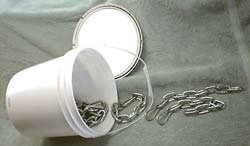
Figure 5: A protein container is perfect for carrying chain micro-weights
The chains and the bucket have a combined weight of about 8.5 lbs - certainly not too much to carry around at the gym. The protein container also does a wonderful job of protecting the chains from the elements if you need to store them outside, in the garage, or even in the back of your truck!
References
- Hatfield, Frederick C., Fitness: The Complete Guide, International Sports Sciences Association, 7th Ed., p. 6.1.
- Spector, Robert E., The HIT FAQ: High Intensity Training, Version 4.1.1, April (2002).
- Haycock, Bryan, "Hypertrophy-Specific Training: Official HST Method," Click here.
- HST FAQ, Click here.
- HST Forum, Click here.
- Piedmont Design Associates, http://www.fractionalplates.com
